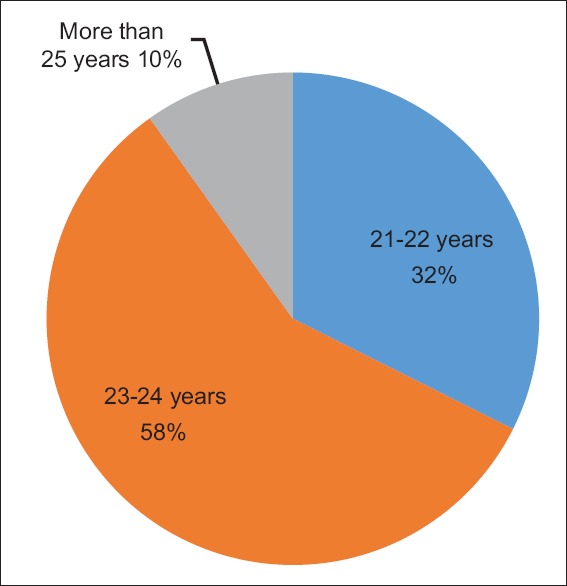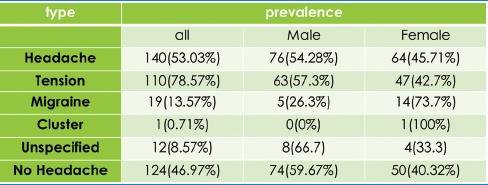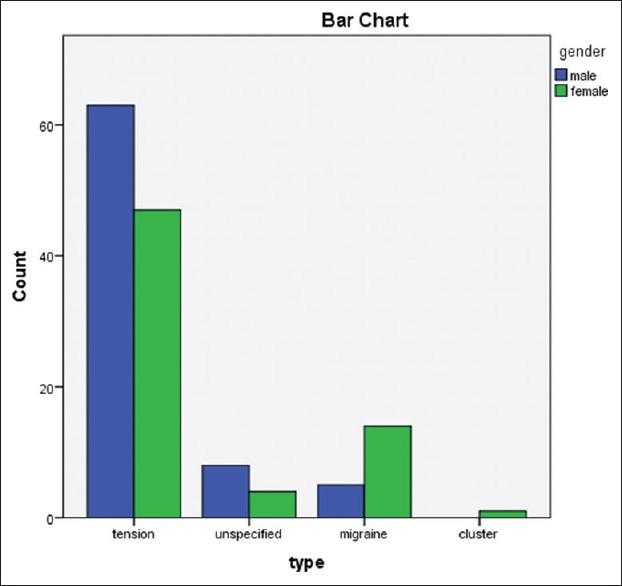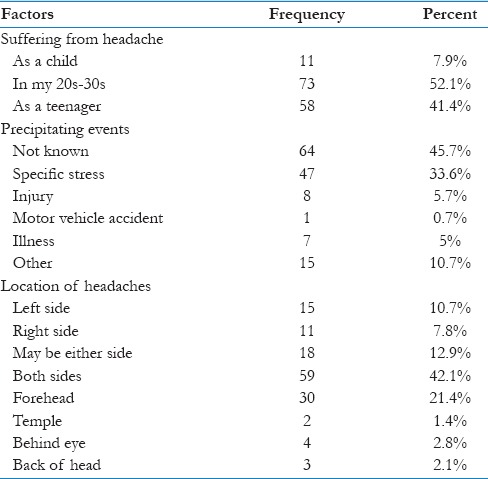Abstract
Background:
Headache is among the commonest complaints in medical students; it could be due to many physical or psychological stressors. It has two main types: primary (including tension-type, migraine, and cluster) and secondary. The aim of this study is to assess the prevalence of headache among male and female medical students.
Materials and Methods:
This study was conducted at KSAU-HS, COM, in January 2018. Third- and fourth-year medical students from both genders who have experienced headache throughout their life or are experiencing it for the past 3 months were included in this study. All medical students completed filling the questionnaire, which consisted of demographical data, headache characteristics and triggers, and associated symptoms.
Results:
A total of 264 [150 (56.81%) males and 114 (43.19%) females] students were evaluated. The prevalence of headache was 53.78%, and the prevalence of tension-type headache was 41.66%. The prevalence of migraine headache was 7.1%. Only one case of cluster headache was detected. Those who did not fit the criteria for the primary types were categorized as unspecified headache. The prevalence of unspecified headache was 3.78%.
Conclusion:
We can conclude from the study that tension-type headache is commonly reported in medical students. It is imperative to provide a stress-free study environment where students can perform more effectively, and sessions on how to reduce stress and alleviate fatigue are highly recommended.
Keywords: Headache, KSAU-HS, prevalence, Riyadh
Introduction/Background
Headache is simply a pain in the head that can originate in a specific area of the head like at the back of the head, on either side of the head, in the frontal part of the head, or confined to the ocular area.[1] Headache can also be generalized, which means the pain can be felt all over the head.[1] International Headache Society published a detailed, long classification of headache which has proven to be very helpful for research purposes; however, all types of headache fall under two types of categories: primary headache, including cluster, migraine, and tension-type headache, and secondary headaches which originate as a result of an underlying disease or medical conditions.[2] Unfortunately, the pathophysiology of the primary headache syndromes is not well understood, but researchers believe that migraine and cluster headaches start as a result of neurological brain dysfunction with subsequent involvement of the cranial vessel and the trigeminal nerve. In the majority of individuals with cluster headache, there is an overactivation of the parasympathetic nervous system. In tension-type headache, there is overactivity either in the cervical or pericranial muscles which could be due to trauma to the neck, improper posture, or anxiety.[2] Headache is one of the most common complaints among medical students due to excessive exposure to physical and psychosocial stressors more than the general population.[3] The severity of headache is directly proportional to the negative impact caused by the headache which includes reduced academic performance, quality of life, impaired functioning, and comorbid psychiatric diagnosis.[4] The impact of headache on medical students is understudied despite the high prevalence.
Primary headache syndromes are much more common than secondary headache. Primary headache syndromes account for 90% of the cases of headache, whereas secondary headache only accounts for 10% of the cases.[2] Internationally, the prevalence of migraine headache, a subtype of primary headache, according to the American Academy of Neurology is estimated to be 18% in woman and 6% in men in the general population.[5] The prevalence of tension-type headache in the general population according to the International Headache Society ranges from 30% to 78% in different studies.[6] The prevalence of cluster headache according to Cleveland Clinic is slightly less than 0.5% in the general population.[2] In Athens University, several researchers tried to identify the prevalence of frequent types of headache among medical students attending the university using two validated questionnaires; they found that 11.9% students (from both genders) suffered from disturbing headache.[7] The prevalence of migraine was 2.4% and 9.5% for tension-type headache (in both genders), whereas cluster headache was not traced.[7] Another cross-sectional study was conducted in Isfahan University of Medical Sciences in Iran, where the prevalence of migraine headache was found to be 14.2% (10.5% in male vs. 18.5% in female, P = 0.08) and tension-type headache prevalence was 44.2% (49.2% in male vs. 39.2% in female, P = 0.006).[8] Locally, in Taibah University in Saudi Arabia, a study was conducted on third-year female medical students to estimate the prevalence of tension-type headache; 58% of students had history of tension headache.[9] In a systematic review through MEDLINE, four articles reported headache prevalence in three Arab countries.[10] The prevalence of headache in Saudi Arabia varied from 8% to 12%, and the prevalence of tension-type headache ranged from 3.1% to 9.5%.[10] In a study conducted to estimate the prevalence of migraine headache among medical students in King Saud bin Abdulaziz University for Health Sciences, the prevalence of migraine was 23.7%. It was significantly higher in females (34.1%) compared with males (18.6%).[10]
Materials and Methods
This cross-sectional study was conducted at King Saud bin Abdulaziz University for Health Sciences, from December 2017 to January 2018. Third- and fourth-year medical students from both genders who have experienced some form of headache in their life and had headache attacks during the past 3 months were included in this study. This study was conducted using the Headache Intake Questionnaire of Cleveland Clinic, Toronto, Ontario, Canada, to diagnose the headache. This questionnaire was modified to fulfil the purpose of the study. The questionnaire was sent to two experts from medical education department and one physician to check the content validity of the questionnaire. Demographic information was collected to compare the prevalence and causes of headache among male and female students. Due to shortage of time, no screening test with the neurologist was done. To fulfil the purpose, a brief self-administered screening tool was used, which consisted of three questions for students with headache complaints. The students who replied “yes” to one item at least were considered a subject with headache. After receiving the approval from King Abdullah International Medical Research Center's, the questionnaire was distributed in the class after taking informed consent. After signing consent form, the students were asked to fill the screening questionnaire and then a research questionnaire including demographic data, triggers causing headache, and management. Participants with no history and incomplete questionnaire were excluded from the study.
Results
A total of 264 students were included in this study; all of them completed the questionnaire. In all, 150 of them were males (56.81%) and 114 were females (43.19%). The mean age of the participants was 23.15 years; 32.5% of the study individuals were between 21 and 22 years, 57.7% were between 23 and 24 years, and 9.8% of the study individuals were 25 years or older (stream 2 students), hence P value was not significant (P = 0.98). There are statistically significant differences about different types of headaches among male and female medical students (P value according to the gender); the level of significant was P = 0.018. Figure 1 shows the age of the participants.
Figure 1.

Age of the participants
The distribution of the study individuals according to the year of study was as follows: 57.9% were fourth-year medical students and 42.1% third-year medical students. There are statistical significant differences about the type of headache among years of the study of medical students (P = 0.037).
The prevalence of headache was 53.78%; the prevalence of tension-type headache was 41.66% (23.86% in male vs. 17.80% in female). The prevalence of migraine headache was 7.1% (1.8% in male vs. 5.30% in female). Only one case of cluster headache was detected. Those who did not fit the criteria for the primary types were categorized as unspecified headache. The prevalence of unspecified headache was 3.78% (3.03% in male vs. 0.75% in female). Final-year medical students had a higher percentage of headache. Table 1 and Figure 2 show the different types of headache according to the gender.
Table 1.
Different types of headache according to the gender

Figure 2.

Different types of headache according to the gender
The most commonly reported location of headache was both sides which was 42.1%, and then forehead which was 21.4%. The majority of students did not know the precipitating event for their headache. About 45.7% of the participants did not know the precipitating event and 33.6% had specific stress as a precipitating event. Most of the students started having headache in their 20s–30s (52.1%). Table 2 shows the factors associated with headache such as precipitating events, location of headaches, and age of suffering from headache.
Table 2.
Factors associated with headache such as precipitating events, location of headaches, and age of suffering from headache

Discussion
The aim of this study is to assess the prevalence of different types of primary headache, migraine, cluster, and tension-type headache, among male and female medical students in King Saud bin Abdulaziz University for Health Sciences in Riyadh, Saudi Arabia. We conducted the study from 2017 to 2018. Our results showed headache to be common among medical students in KSAU-HS with an overall prevalence of 53.78%. A number of studies on medical students have similarly shown high prevalence of headache.[3,7] Several studies have shown higher prevalence rate of headache among females than males. This preponderance is not observed in the subjected population, but it could be due to the slightly higher male-to-female participant ratio (1.3:1). The prevalence of migraine headache is 7.1% which is closely similar to that (6.4%) among medical students reported by Ojini et al. from the University of Lagos in Nigeria.[11] Nevertheless, the prevalence of migraine was almost half of that reported by Ghorbani et al. among medical students in Isfahan University, Iran, which is 14.2%.[3]
In this study, tension-type headache was higher in both genders with a prevalence of 41.66% (23.86% in male vs. 17.80% in female). In multiple studies, the rate of tension-type headache has shown wide variability, ranging from 5.9% to 34.5% in males and 11.1% to 40.8% in females.[3] The prevalence of tension-type headache in our population is 41.66% which is closely similar to the prevalence found among medical students in Isfahan University, Iran.[3] Nevertheless, the prevalence of tension-type headache, 41.66%, is higher than that seen in local studies like the prevalence of tension-type headache in Tibah University, Almadinah, Saudi Arabia, which is 14.1%.[12] Several studies have shown an association between age and different types of headache.[12] In our population, the age range is very narrow, and we could not find any association between age and different types of headache.
In our result, we found out that the prevalence of headache is slightly higher in fourth-year and final-year medical students, than third-year medical students. This could be explained by the continuous stress that they are exposed to because of the preparation for Saudi Medical Licensing Exam.
One of the limitations of our study is that our participants were not examined by a neurologist, therefore inaccurate diagnosis could be minimized. This study is relevant to the practice of family physician because students who complain of headache visit the primary care clinic first. Also, this study discussed the prevalence of headache among medical students which is associated with public health that could be prevented and managed by family medicine.
Conclusion/Recommendation
We can conclude from the study that headache is a very common complaint among medical students and tension-type headache is the commonest type. Tension-type headache was more common in males than females. Migraine was the second most common type of headache. The prevalence of migraine was more in female students. A single case of cluster headache was detected in female student. It is imperative to provide a stress-free study environment where students can perform more effectively, and sessions on how to reduce stress and alleviate fatigue are highly recommended. This study was carried out in only one college which gives a limited sample, and therefore results cannot be generalized on students from different colleges. Studies on larger sample are suggested.
Financial support and sponsorship
Nil.
Conflicts of interest
There are no conflicts of interest.
Acknowledgement
We would like to acknowledge and show our sincere gratitude and thank Dr. Assil Albrekeit for her great effort in Data collection.
References
- 1.Medical definition of headache. 2016. Available from: https://www.medicinenet.com/script/main/art.asp?articlekey=11396 .
- 2.Kunkel RS. Headache. Center for continuing education. The Cleveland Foundation. 2010. [Last accessed on 2017 Nov 16]. Available from: http://www.clevelandclinicmeded.com/medicalpubs/diseasemanagement/neurology/headachesheadache . ICHD.-3yndromes/
- 3.Ghorbani A, Abtahi S, Fereidan-Esfahani M, Abtahi S, Shemshaki H, Akbari M, et al. Prevalence and clinical characteristics of headache among medical students, Isfahan, Iran. J Res Med Sci. 2013;18(Suppl 1):S24–7. [PMC free article] [PubMed] [Google Scholar]
- 4.Smitherman TA, McDermott MJ, Buchanan EM. Negative impact of episodic migraine on a university population: Quality of life, functional impairment, and comorbid psychiatric symptoms. Headache. 2011;51:581–9. doi: 10.1111/j.1526-4610.2011.01857.x. [DOI] [PubMed] [Google Scholar]
- 5.American Academy of Neurology. AAN summary of evidence-based guideline for clinicians: Migraine headache. 2009. Available from: https://www.aan.com/guidelines/home/getguidelinecontent/120 .
- 6.Olesen J, Bes A, Kunkel R, Lance JW, Nappi G, Pfaffenrath V, et al. Tension-type headache – ICHD-3 Beta. The International Classification of Headache Disorders 3rd edition (Beta version) 2016. Available from: https://www.ichd-3.org/2-tension-type-headache .
- 7.Mitsikostas DD, Gatzonis S, Thomas A, Kalfakis N, Ilias A, Papageoergiou C. An epidemiological study of headaches among medical students in Athens. Headache. 1996;36:561–4. doi: 10.1046/j.1526-4610.1996.3609561.x. [DOI] [PubMed] [Google Scholar]
- 8.Al-Jabry NT, Abduljabbar AZ, Maqsud AN, Alhadad BA, Almukhtar NM, et al. Prevalence and risk factors of tension headache among 3rd year female medical students at Taibah University in Saudi Arabia. Int J Acad Sci Res. 2015;3:46–53. [Google Scholar]
- 9.Saeed RM, Saeed HM, Al-Harby MA, Alsoheeme NS, Al-Ofui EE, Metwally MH. Prevalence of headache among Taibah University students in Al Madinah. Int J Med Res Prof. 2018;4:71–8. [Google Scholar]
- 10.Alwahbi MK, Alamri MM, Alammar AM, Alanazi AM, Alotaibi AG, Alharbi SK, et al. Prevalence of migraine among medical students of King Saud Bin Abdulaziz University for Health Sciences. Int J Sci Res. 2015;6:894–8. [Google Scholar]
- 11.Ojini FI, Okubadejo NU, Danesi MA. Prevalence and clinical characteristics of headache in medical students of the University of Lagos, Nigeria. Cephalalgia. 2009;29:472–7. doi: 10.1111/j.1468-2982.2008.01766.x. [DOI] [PubMed] [Google Scholar]
- 12.Saeed RM, Saeed HM, Al-Harby MA, Alsoheeme NS, Al-Ofui EE, Metwally MH. Prevalence of Headache among Taibah University students in Al Madinah. Int J Med Res Prof. 2018;4:71–8. [Google Scholar]


